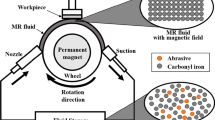Abstract
Multi-pole arrangements in magnetorheological plane finishing technology have been investigated in this study. A method of combining the material removal mechanism of micro-points using the empirical Preston equation is proposed to establish a prediction model for surface flatness, and the new Semiconductor Equipment and Materials International (SEMI) standard has been used to evaluate workpiece surface flatness. Based on the model, the effects of process parameters (polishing time, speed ratio, translational amplitude, polishing gap, etc.) on the flatness of workpieces with different shapes are predicted through simulation, and the effects of multi-pole arrangements are explored. The results of the analysis indicate that with changes in process parameters, the extent of change in surface flatness differs based on the shape of the workpiece. After polishing, concave workpieces show the highest levels of surface flatness. From simulations of magnetic pole arrangements, it is also found that magnetic field generators with different magnetic pole arrangements can be used for workpieces with different shapes to improve their surface flatness. Experiments with a workpiece with its shape measured using a white light interferometer showed that the surface flatness improved from being 33.561 μm initially to 21.822 μm after polishing, thereby demonstrating the effectiveness of the proposed method.























Similar content being viewed by others
References
Zhang P, Dong YZ, Choi HJ, Lee CH, Gao YS (2020) Reciprocating magnetorheological polishing method for borosilicate glass surface smoothness. J Ind Eng Chem 84:243–251. https://doi.org/10.1016/j.jiec.2020.01.004
Dai YF, Peng XQ (2013) Overview of key technologies for optical manufacturing of lithographic projection lens. J Mech Eng 49:10–18
Huang Y, He S, Xiao GJ, Li W, Jiahua SL, Wang WX (2020) Effects research on theoretical-modelling based suppression of the contact flutter in blisk belt grinding. J Manuf Process 54:309–317. https://doi.org/10.1016/j.jmapro.2020.03.021
Luo B, Yan Q, Pan J, Guo M (2020) Uniformity of cluster magnetorheological finishing with dynamic magnetic fields formed by multi-magnetic rotating poles based on the cluster principle. Int J Adv Manuf Technol 107:919–934. https://doi.org/10.1007/s00170-020-05088-1
Parameswari G, Jain VK, Ramkumar J, Nagdeve L (2019) Experimental investigations into nanofinishing of Ti6Al4V flat disk using magnetorheological finishing process. Int J Adv Manuf Technol 100:1055–1065. https://doi.org/10.1007/s00170-017-1191-3
Guo CW, Chen F, Meng QR, Dong ZX (2014) Yield shear stress model of magnetorheological fluids based on exponential distribution. J Magn Magn Mater 360:174–177. https://doi.org/10.1016/j.jmmm.2014.02.040
Chen MJ, Liu HN, Cheng J, Yu B, Fang Z (2017) Model of the material removal function and an experimental study on a magnetorheological finishing process using a small ball-end permanent-magnet polishing head. Appl Opt 56:5573–5582. https://doi.org/10.1364/AO.56.005573
Wang YY, Zhang Y, Feng ZJ (2016) Analyzing and improving surface texture by dual-rotation magnetorheological finishing. Appl Surf Sci 360:224–233. https://doi.org/10.1016/j.apsusc.2015.11.009
Kordonski W, Gorodkin S (2011) Material removal in magnetorheological finishing of optics. Appl Opt 50:1984–1994. https://doi.org/10.1364/AO.50.001984
Catrin R, Neauport J, Taroux D, Cormont P, Maunier C, Lambert S (2014) Magnetorheological finishing for removing surface and subsurface defects of fused silica optics. Opt Eng 53(0920109):092010. https://doi.org/10.1117/1.OE.53.9.092010
Saraswathamma K, Jha S, Rao PV (2015) Experimental investigation into ball end magnetorheological finishing of silicon. Precis Eng 42:218–223. https://doi.org/10.1016/j.precisioneng.2015.05.003
Dai YF, Song C, Peng XQ, Shi F (2010) Calibration and prediction of removal function in magnetorheological finishing. Appl Opt 49:298–306
Kumar S, Singh AK (2018) Nanofinishing of BK7 glass using a magnetorheological solid rotating core tool. Appl Opt 57:942–951. https://doi.org/10.1364/AO.57.000942
Pan JQ, Yu P, Yan QS (2018) Experimental investigations on the polishing forces characteristics of dynamic magnetic field magnetorheological effect polishing pad. J Mech Eng 54:10–17
Wang YQ, Yin ZH, Li YP, Hu T, Chen FJ (2017) Effects of translational movement on surface planarity in magnetorheological planarization process. J Mech Eng 53:206–214. https://doi.org/10.3901/JME.2017.01.206
Zhang YF, Fang FZ, Huang W, Wang C, Fan W (2018) Polishing technique for potassium dihydrogen phosphate crystal based on magnetorheological finishing. Procedia CIRP 71:21–26. https://doi.org/10.1016/j.procir.2018.05.012
Fang CF, Zhao ZX, Lu LY, Lin YF (2016) Influence of fixed abrasive configuration on the polishing process of silicon wafers. Int J Adv Manuf Technol 88(1–4):1–10. https://doi.org/10.1007/s00170-016-8808-9
Krishnan M, Nalaskowski JW, Cook LM (2010) Chemical mechanical planarization: slurry chemistry, materials, and mechanisms. Chem Rev 110:178–204. https://doi.org/10.1021/cr900170z
Nie M, Cao JG, Liu YM, Li JY (2018) Influence of magnets’ phyllotactic arrangement in cluster magnetorheological effect finishing process. Int J Adv Manuf Technol 99:1699–1712. https://doi.org/10.1007/s00170-018-2603-8
Guan F, Hu H, Li SY, Liu ZY, Peng XQ, Shi F (2018) A novel lap-MRF method for large aperture mirrors. Int J Adv Manuf Technol 95:4645–4657. https://doi.org/10.1007/s00170-017-1498-0
Zou YH, Jiao AY, Aizawa T (2010) Study on plane magnetic abrasive finishing process-experimental and theoretical analysis on polishing trajectory. Adv Mater Res 126–128:1023–1028. https://doi.org/10.4028/www.scientific.net/amr.126-128.1023
Lu JB, Yan QS, Pan JS, Gao WQ (2012) Experiments of synergistic effect of electro-magnetically coupled field in EMR finishing. Opt Precis Eng 20:2485–2491
Pan J, Yan Q (2015) Material removal mechanism of cluster magnetorheological effect in plane polishing. Int J Adv Manuf Technol 81(9–12):2017–2026. https://doi.org/10.1007/s00170-015-7332-7
Jha S, Jain VK (2006) Modeling and simulation of surface roughness in magnetorheological abrasive flow finishing (MRAFF) process. Wear 261:856–866. https://doi.org/10.1016/j.wear.2006.01.043
Pan JS, Yan QS, Xu XP, Zhu JT, Wu ZC, Bai ZW (2012) Abrasive particles trajectory analysis and simulation of cluster magnetorheological effect plane polishing. Phys Procedia 25:176–184. https://doi.org/10.1016/j.phpro.2012.03.067
Zhao DW, Wang TQ, He YY, Lu XC (2013) Kinematic optimization for chemical mechanical polishing based on statistical analysis of particle trajectories. IEEE Trans Semicond Manuf 26:556–563. https://doi.org/10.1109/TSM.2013.2281218
Rastegar V (2018) Effect of large particles during chemical mechanical polishing based on numerical modeling of abrasive particle trajectories and material removal non-uniformity. IEEE Trans Semicond Manuf 31:277–284. https://doi.org/10.1109/TSM.2018.2796564
Author information
Authors and Affiliations
Corresponding author
Additional information
Publisher’s note
Springer Nature remains neutral with regard to jurisdictional claims in published maps and institutional affiliations.
Rights and permissions
About this article
Cite this article
Liu, Z., Li, J., Nie, M. et al. Modeling and simulation of workpiece surface flatness in magnetorheological plane finishing processes. Int J Adv Manuf Technol 111, 2637–2651 (2020). https://doi.org/10.1007/s00170-020-06267-w
Received:
Accepted:
Published:
Issue Date:
DOI: https://doi.org/10.1007/s00170-020-06267-w



